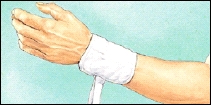UNDERSTANDING RESTRAINTS
Restraints help keep patients as safe as possible. This handout may help answer some of your questions. If you have any other questions or concerns, talk to the healthcare provider.
WHY RESTRAINTS ARE USED
Some medications or illnesses can cause confusion. A patient may not remember where he or she is or why he or she is there. Restraints help keep patients from harming themselves. Restraints can help prevent such things as:
-
Removing tubes or bandages
-
Scratching at wounds or bandages
-
Prevent harm to self or others
 |
| Wrist restraints keep a patient from pulling tubes out. |
HOW RESTRAINTS ARE USED
Many types of restraints are available. Each type has a purpose. Very strict guidelines say how a restraint can be used and for how long. Health care providers should do the following:
-
Use restraints only after other alternatives have been tried.
-
Choose the least limiting restraint possible.
-
Check the skin under the restraint often.
-
Keep a call button within the patient’s reach when a restraint is in place.
-
Remove the restraint as soon as it is no longer needed.
-
Preserve the patient’s dignity.
HOW YOU CAN HELP
Know that your loved one will be assisted, if necessary, in doing everything he or she needs. This includes eating, bathing, and using the toilet.
© 2000-2025 The StayWell Company, LLC. All rights reserved. This information is not intended as a substitute for professional medical care. Always follow your healthcare professional's instructions.